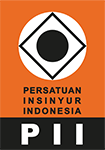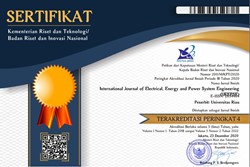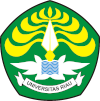PLTD Engine Tank Oil Volume Monitoring System using HC-SR04 Ultrasonic Sensor Based on Internet of Things (IoT)
Abstract
The Diesel Power Plant is an oil-fired generator. The PLTD engine in Ranai uses Bio Solar fuel to produce 1 MW (MegaWatt) of power. The PLTD engine in Ranai each has one tank with a capacity of 1820 liters. Within 1 hour of using a machine with a power of ±, 750 KW (Kilo Watt) can consume ± 182 liters of oil. The IoT system serves to simplify the work in the oil distribution system. This IoT system uses the ESP8266 as a microcontroller, the HC-SR04 ultrasonic sensor as a volume level reader for the oil in the engine tank, and a relay as a replacement switch pump on or off. This tool works in real-time to help reduce the risk of negligence in refueling the engine. The Device testing results showed good results because the error value in the measurement distance test was 0%. The tool can provide fast and accurate information because it is equipped with an information system using Android and notifications from email messages.
References
[1] Mohammad Salah Uddin Chowdury, “IoT Based Real-time River Water Quality Monitoring System”, Procedia Computer Science, pp. 161–168, 2019.
[2] Sharmad Pasha, “Thingspeak Based Sensing and Monitoring System for IoT with Matlab Analysis”, International Journal of New Technology and Research (IJNTR), Volume 2, Issue 6, pp. 19-23, 2016.
[3] Aldrin C. Tasonga, Roland P. Abao, “Design and Development of an IoT Application with Visual Analytics for Water Consumption Monitoring”, Procedia Computer Science, pp. 205–213, 2019.
[4] Sorongan, A., Hidayanti, Q., Priyono, K., “ThingSpeak Sebagai Sistem Monitoring Tangki SPBU Berbasis Internet Of Things”, JTERA - Jurnal Teknologi Rekayasa, Vol. 3, No. 2, pp. 219-224, 2018.
[5] Pratama, N., “Perancangan Sistem Monitoring Ketinggian Air Sebagai Pendeteksi Banjir Berbasis IoT Menggunakan Sensor Ultrasonik”, Jurnal Media Informatika Budidarma, Vol. 4, No.2, 2020.
[6] Rony, M.A., Irawan, “Aplikasi Monitoring Volume Tangki Solar Menggunakan Sensor Ping Ultrasonik Berbasis Android”, Prosiding SENDI, 2019.
[7] M. I. Bello, 2018. “Autonomous Ultrasonic Based Water Level Detection and Control System”, Nigerian Journal of Technology (NIJOTECH), Vol. 37, No. 2, pp. 508-513, 2018.
[8] Saleem Latteef Mohammed, “Highly Accurate Water Level Measurement System Using a Microcontroller and an Ultrasonic Sensor”, IOP Conf. Series: Materials Science and Engineering, 2019.
[9] Ma’ruf, I., Hadi, A, “Monitoring kontrol level air menggunakan sensor ultrasonik berbasis PC”, Seminar Nasional Industri dan Teknologi (SNIT), Politeknik Negeri Bengkalis, 2019.
[10] Amin, Ahmadil, “Monitoring Water Level Control Berbasis Arduino UNO Menggunakan LCD LM016L”, Jurnal EEICT, Vol. 1, No. 41, 2018.
[11] Yusnita Rahayu and Muhammad Ibnu Hidayat, “Bluetooth Based Home Control and Real-Time Energy Consumption Monitoring System through Smartphone”, International Journal of Electrical, Energy and Power System Engineering (IJEEPSE), Vol. 2, No. 3, pp. 5-9, 2019.
[12] Rizki, M, “Perancangan Kontrol dan Monitoring Level Ketinggian Air di Waduk Bagian Hulu Untuk Meningkatkan Efektifitas Kinerja PLTA Kota Panjang”, Jurnal FTEKNIK, Vol. 3, No. 1, 2016.



















